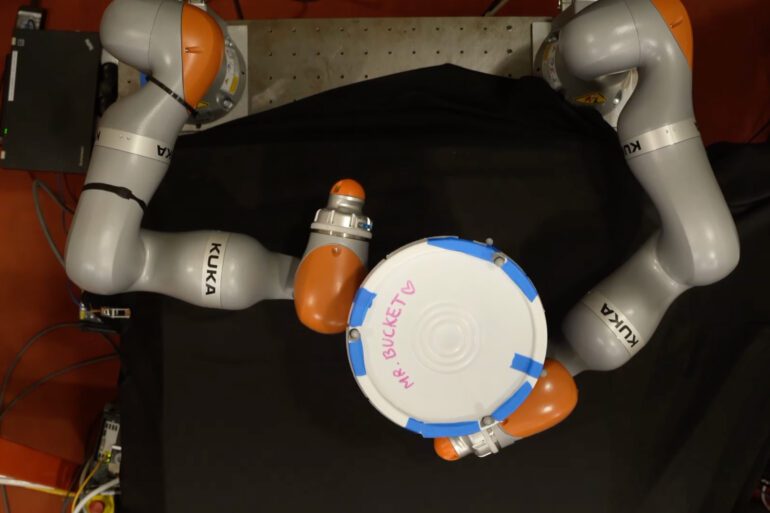TL;DR:
- Researchers at MIT’s CSAIL pioneer robotic dexterity through “smoothing” reinforcement learning, enabling intricate object manipulation.
- University of Bristol introduces “Bi-Touch,” a dual-arm tactile robotic system mastering tasks like object nudging and rotation.
- Stanford University leverages human video demos for teaching robots complex tasks, boosting success rates by 58%.
- Combined advancements pave the way for robots mirroring human-like object manipulation.
- Implications span industries, enhancing manufacturing precision and surgical outcomes.
Main AI News:
In the realm of technological marvels, a profound evolution is underway, as researchers delve into the realm of robotic dexterity and tactile acumen. The ultimate vision? To bestow upon robots the remarkable ability to manipulate objects with the finesse and precision reminiscent of human hands.
Pioneering this research frontier is a trailblazing study hailing from none other than MIT’s Computer Science and Artificial Intelligence Lab (CSAIL). At its core lies an audacious endeavor to conquer the intricate domain of contact-rich manipulation – a sphere where robots engage with objects in a symphony of complex interactions.
Unveiling the crux of the challenge, the study elucidates, “The hybrid nature of contact dynamics presents the central hurdle in planning through contact.”
A lodestar guiding these ambitious endeavors is reinforcement learning, an AI technique harnessing the power of rewards and penalties to cultivate aptitude. The researchers at CSAIL have ingeniously employed a variant of this technique, termed “smoothing,” to emulate the sensory journey undertaken by living entities – a journey now poised to be replicated by rudimentary robots.
Even more captivating is the synergy of their approach with sampling-based motion planning, an alliance that paves a path towards intricate manipulation characterized by myriad contact points. Imagine a robot deftly employing two hands to engage with and masterfully maneuver objects. In the crucible of experimentation, these techniques have birthed the capacity for intricate movements to materialize within minutes, a quantum leap from the traditional, time-intensive methodologies of yore.
Across the Atlantic, the University of Bristol has unveiled “Bi-Touch,” a pioneering archetype of dual-arm tactile robotic finesse. “A suite of bimanual manipulation tasks tailored towards tactile feedback: bi-pushing, bi-reorienting, and bi-gathering,” elucidates the research paper, outlining the system’s multifaceted capabilities. Enabled by sim-to-real deep reinforcement learning, this marvel masters tasks of finesse, from harmonized object nudges to deft object rotations.
Meanwhile, on the sun-soaked shores of the West Coast, researchers at Stanford University are orchestrating a symphony of human video demonstrations to teach robots intricate undertakings. By capitalizing on masked eye-in-hand camera footage, they have circumvented the cumbersome need for intricate image translations between the human and robotic realms.
As the researchers aptly posit, “Videos of humans performing tasks… eliminate the need for robotic teleoperation expertise.”
In essence, just as individuals acquire skills through online tutorials, these researchers are harnessing the power of videos to imbue robots with newfound talents. This innovative approach has propelled success rates in novel scenarios by an astonishing 58%, eclipsing the benchmarks set by conventional robot data training.
In collective concert, these paradigm-shifting studies are sculpting the silhouette of a robotic future, one where objects are deftly maneuvered with a finesse rivaling human prowess. Industries, from manufacturing floors to sterile operating theaters, stand on the cusp of transformation. Envision, if you will, a surgical scenario where an AI-fueled robotic ally collaborates with a surgeon, ushering in a new epoch of precision and optimal outcomes.
To the enthusiasts of science fiction, take heed. The notion of affable robotic aides need not eclipse the prospect of harmonious coexistence. As long as these mechanical companions reserve their penchant for banter with their human counterparts rather than any grand design of elimination, the horizon remains promisingly clear.
Conclusion:
The synergy of cutting-edge AI techniques and tactile mastery is ushering in a new era of robotics. MIT’s groundbreaking “smoothing” reinforcement learning, coupled with Bristol’s dual-arm system and Stanford’s video-based teaching, is transforming object manipulation capabilities. This seismic shift holds the potential to revolutionize industries, offering heightened precision in manufacturing and medical procedures. As these technologies mature, market players embracing these innovations stand poised to gain a competitive edge in an increasingly automated landscape.

